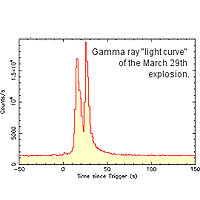Battery-Powered Balancing Robot DIY STEM Kit
$9.99$4.95
Posted on: Apr 10, 2003

Scientists have discovered that one of the brightest gamma ray bursts on record is also a supernova. It's the first direct evidence linking these two types of explosions, both triggered by the death of a massive star.
NASA's High-Energy Transient Explorer satellite (HETE) initially detected the burst on March 29, 2003, in the constellation Leo. For more than 30 seconds, the burst outshone the entire universe in gamma rays.
Two hours later, the explosion's optical afterglow remained a trillion times more luminous than the Sun. Although the fireball was about two billion light-years away, it was nevertheless bright enough to be detected by small telescopes on Earth. Sky watchers in Japan, for instance, had no trouble photographing the fading afterglow using a 12" telescope at the Tokyo Institute of Technology.
In Arizona, astronomers turned the Multiple Mirror Telescope (MMT) at Mount Hopkins toward the gamma ray burst afterglow and soon spotted the telltale signs of a supernova. Scientists cannot yet determine which came first, the burst or the supernova, but the same event, a star explosion, was certainly the trigger for both.
"There should no longer be doubt in anybody's mind that gamma ray bursts and supernovae are connected," said Thomas Matheson of the Harvard-Smithsonian Center for Astrophysics (CfA), Cambridge, Mass., and a member of the team that made the discovery. Matheson's colleagues include Peter Garnavich of Notre Dame and Krzysztof Stanek of the CfA.
Gamma ray bursts are the most powerful explosions in the universe, and they likely signal the birth of black holes. Bursts occur at random locations scattered across the sky. Few last more than a minute, making them hard to study.
A supernova is the explosion of a star at least eight times as massive as the sun. When such stars deplete their nuclear fuel, they no longer have the energy to support their mass. Their cores implode, forming either a neutron star or, if there is enough mass, a black hole. The surface layers of the star blast outward, forming the colorful patterns typical of supernova remnants.
Previous observations, particularly from NASA's Chandra X-ray Observatory, have provided convincing indirect evidence of the gamma ray burst/supernova connection. The Chandra Observatory detected iron and other heavy elements, which are formed in supernovas, in the vicinity of gamma ray bursts.
But this latest burst has provided a direct link: light from the afterglow itself exhibits the same patterns as light from a supernova. Namely, the scientists see changes in light absorbed by silicon and iron atoms, forged in the supernova, as the afterglow slowly fades away. Matheson's team is continuing to observe and analyze this unique burst.
"Scores of observatories, and even more observers, are now studying this event," said Don Kniffen, at NASA Headquarters in Washington. "We've been searching for a direct link for decades, and we finally got it," he said.
"All gamma ray bursts may have associated supernovae that are too faint to observe," Matheson said. The March 29 burst, named GRB 030329, was one of the closest to Earth. It was approximately two billion light-years away, as opposed to other bursts located more than 10 billion light-years away. Because the burst was both relatively close to Earth and bright, the supernova was detectable ... and the long-sought missing link was finally found.
 'When I examine myself and my methods of thought, I come to the conclusion
that the gift of fantasy has meant more to me than my talent for absorbing
positive knowledge.'
'When I examine myself and my methods of thought, I come to the conclusion
that the gift of fantasy has meant more to me than my talent for absorbing
positive knowledge.'